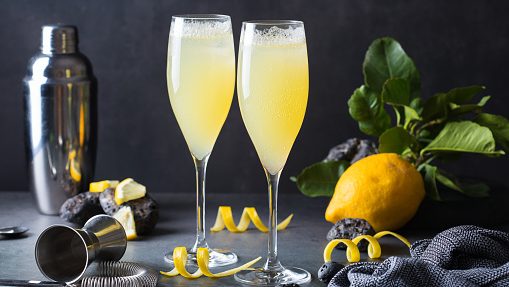
The enduring legacy of the French 75 cocktail

For so many mixologist creations, the drink’s origins remain shrouded in mystery. The classic French 75 cocktail is among them. Despite its largely forgotten history, the cocktail has survived through the decades and managed to make a name for itself well beyond the countertop.
The French 75 has appeared in movies like “Casablanca.” It has been invoked in the naming of bars and galleries and taken center stage at New York Fashion Week with a French 75-inspired gown. So, what is the primary ingredient keeping the boozy cocktail alive?
A book released this week dives into the resilience of the drink, examines what it says about cocktail culture and explores the components of the concoction. John Maxwell Hamilton, a professor at Louisiana State University and a fellow at the Woodrow Wilson International Center for Scholars, is the author of the aptly titled “The French 75.”
“Marketplace Morning Report” host David Brancaccio spoke with Hamilton about the book and the drink. The following is an edited transcript of their conversation.
David Brancaccio: Why do they call this thing the French 75?
John Maxwell Hamilton: This is a cocktail that was born out of propaganda and carries on because it’s so easily publicized. It was created in World War I and named after a famous cannon, 75-millimeter cannon, which the French used in that war. It helped them a great deal because it was the first modern artillery piece. Some people think it actually helped save Paris when the Germans marched in.
Brancaccio: Somehow that reference helped give it cachet.
Hamilton: The French were first struggling in the war, and they wanted something that they could hang propaganda on. And because the French 75 gun was so effective, it was a way for them to create this aura about the war and the gun. And then of course, a whole lot of other things were named French 75s: cocktail shakers, chocolate, spools of cotton, handkerchiefs, cigarette lighters. The French 75 became this name that you use for promotion.
Brancaccio: Marketing didn’t go out of business after the First World War, and that helped over the years.
Hamilton: You’re right. Promotion did carry on. In fact, you could argue that modern advertising and public relations grew out of World War I. The tactics we use now to sell and to brand things really began in that conflict.
Brancaccio: But over the years, somehow this French 75 keeps getting new life as people attach their brands to it, attach their names to it.
Hamilton: The drink itself, its history is forgotten. But the name has a certain “je ne sais quoi.” If you order a French 75, there’s something about you. You’re cosmopolitan.
The other side is the drink has managed to reinvent itself over and over again. So, the first one had Calvados in it. It had absinthe and gin. The ones that exist today, sometimes they have gin and Champagne. There’s one in the Atlas bar in Singapore and it has crème pêche and salt. So it changes all the time.
Brancaccio: Indeed. I keep seeing statistics that Generation Z is consuming less alcohol, sober-curious mindset, to be praised. Is there a way to do a French 75 that might be nonalcoholic?
Hamilton: I’m sorry to say there is. You can also do French 75 Jell-O shots. But if you don’t want to drink a French 75 that has alcohol in it, go get a Dr Pepper.
There’s a lot happening in the world. Through it all, Marketplace is here for you.
You rely on Marketplace to break down the world’s events and tell you how it affects you in a fact-based, approachable way. We rely on your financial support to keep making that possible.
Your donation today powers the independent journalism that you rely on. For just $5/month, you can help sustain Marketplace so we can keep reporting on the things that matter to you.

















